Professional Portfolio: Healthcare, Ethics, and Conduct
VerifiedAdded on 2021/04/19
|17
|4047
|28
Portfolio
AI Summary
This professional portfolio provides a comprehensive overview of various aspects within the healthcare field. It begins with an exploration of learning theories, including Kolb's learning cycle, and the importance of feedback and reflective practice. The portfolio then delves into professional identity, conduct, and ethical considerations, including confidentiality, CPD, and clinical governance. Key topics such as informed consent, equality, and diversity are also addressed, along with health and safety protocols, infection control, and patient-centered care. The document also covers the structure of the NHS and essential procedures like basic life support and blood pressure monitoring. References are included to support the information presented, offering a detailed insight into the practical application of these concepts within a healthcare setting.
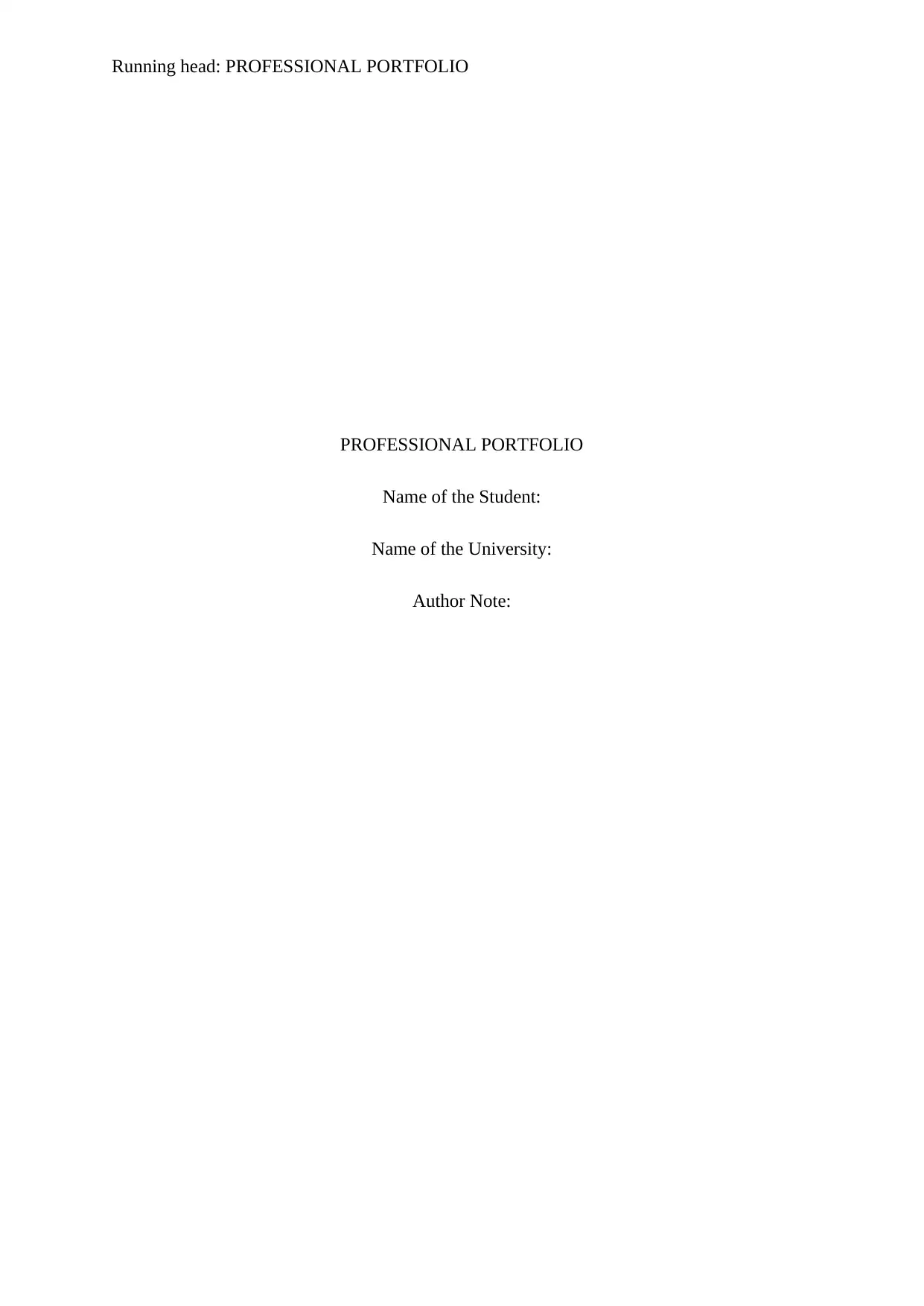
Running head: PROFESSIONAL PORTFOLIO
PROFESSIONAL PORTFOLIO
Name of the Student:
Name of the University:
Author Note:
PROFESSIONAL PORTFOLIO
Name of the Student:
Name of the University:
Author Note:
Paraphrase This Document
Need a fresh take? Get an instant paraphrase of this document with our AI Paraphraser
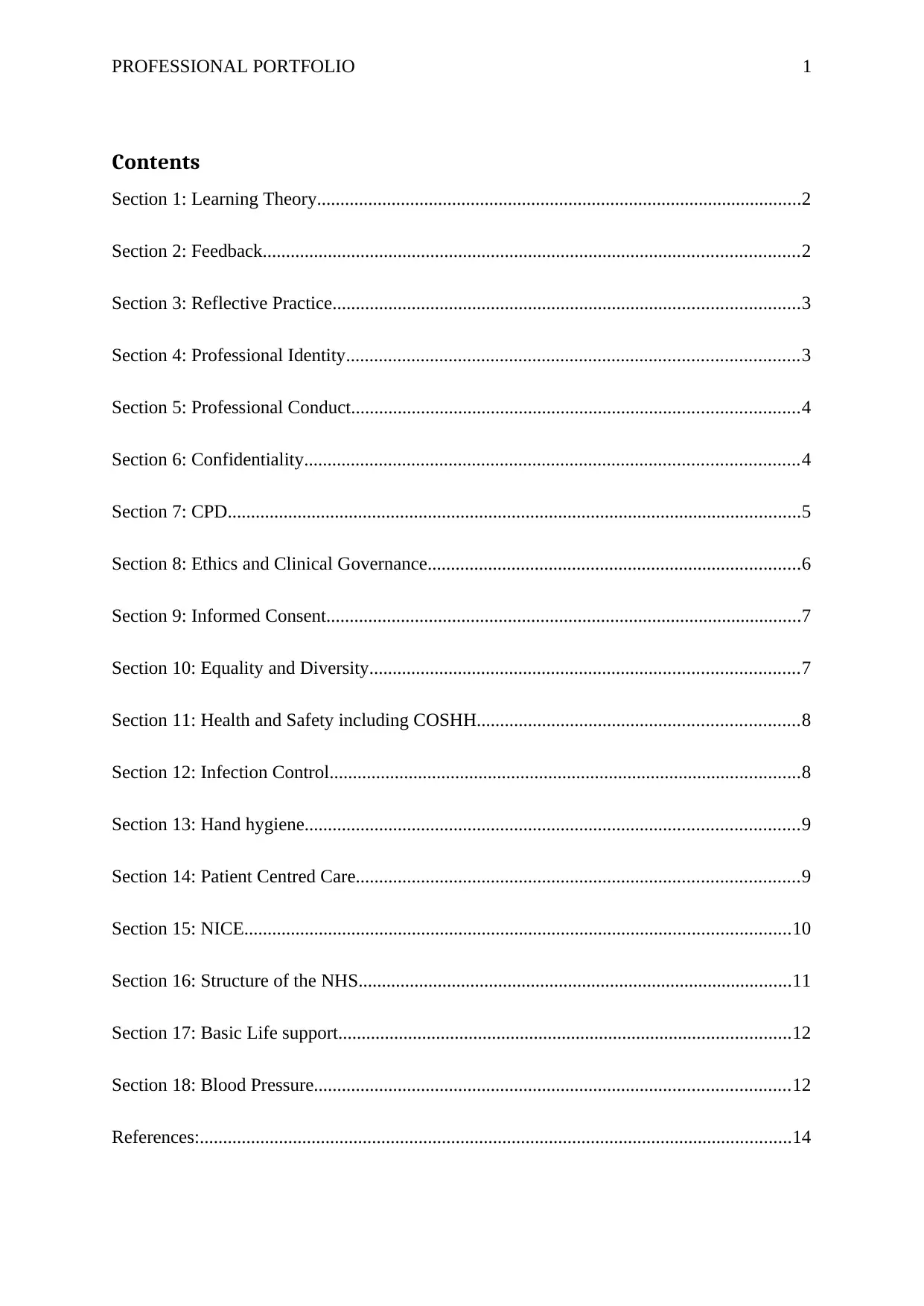
PROFESSIONAL PORTFOLIO 1
Contents
Section 1: Learning Theory........................................................................................................2
Section 2: Feedback...................................................................................................................2
Section 3: Reflective Practice....................................................................................................3
Section 4: Professional Identity.................................................................................................3
Section 5: Professional Conduct................................................................................................4
Section 6: Confidentiality..........................................................................................................4
Section 7: CPD...........................................................................................................................5
Section 8: Ethics and Clinical Governance................................................................................6
Section 9: Informed Consent......................................................................................................7
Section 10: Equality and Diversity............................................................................................7
Section 11: Health and Safety including COSHH.....................................................................8
Section 12: Infection Control.....................................................................................................8
Section 13: Hand hygiene..........................................................................................................9
Section 14: Patient Centred Care...............................................................................................9
Section 15: NICE.....................................................................................................................10
Section 16: Structure of the NHS.............................................................................................11
Section 17: Basic Life support.................................................................................................12
Section 18: Blood Pressure......................................................................................................12
References:...............................................................................................................................14
Contents
Section 1: Learning Theory........................................................................................................2
Section 2: Feedback...................................................................................................................2
Section 3: Reflective Practice....................................................................................................3
Section 4: Professional Identity.................................................................................................3
Section 5: Professional Conduct................................................................................................4
Section 6: Confidentiality..........................................................................................................4
Section 7: CPD...........................................................................................................................5
Section 8: Ethics and Clinical Governance................................................................................6
Section 9: Informed Consent......................................................................................................7
Section 10: Equality and Diversity............................................................................................7
Section 11: Health and Safety including COSHH.....................................................................8
Section 12: Infection Control.....................................................................................................8
Section 13: Hand hygiene..........................................................................................................9
Section 14: Patient Centred Care...............................................................................................9
Section 15: NICE.....................................................................................................................10
Section 16: Structure of the NHS.............................................................................................11
Section 17: Basic Life support.................................................................................................12
Section 18: Blood Pressure......................................................................................................12
References:...............................................................................................................................14
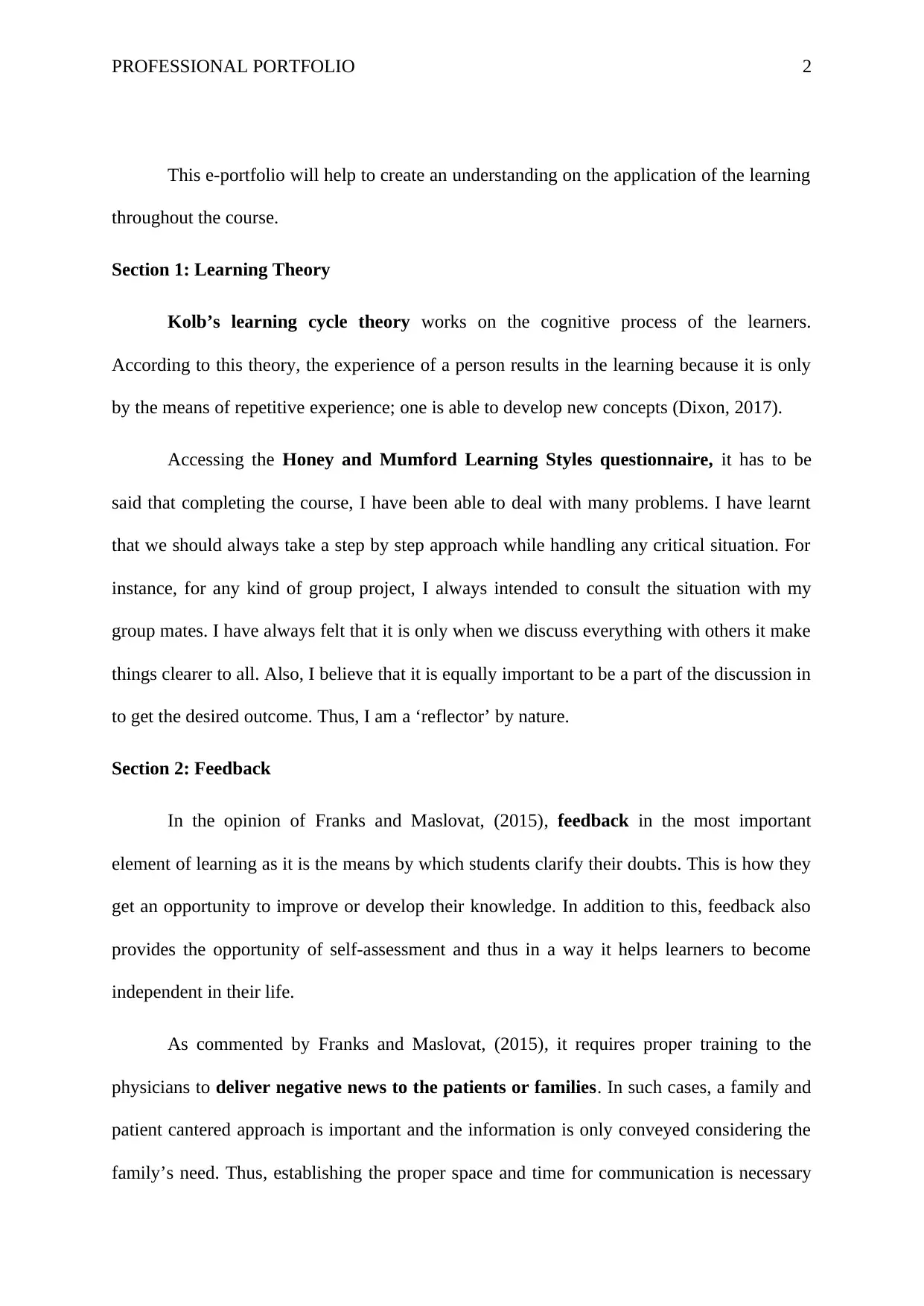
PROFESSIONAL PORTFOLIO 2
This e-portfolio will help to create an understanding on the application of the learning
throughout the course.
Section 1: Learning Theory
Kolb’s learning cycle theory works on the cognitive process of the learners.
According to this theory, the experience of a person results in the learning because it is only
by the means of repetitive experience; one is able to develop new concepts (Dixon, 2017).
Accessing the Honey and Mumford Learning Styles questionnaire, it has to be
said that completing the course, I have been able to deal with many problems. I have learnt
that we should always take a step by step approach while handling any critical situation. For
instance, for any kind of group project, I always intended to consult the situation with my
group mates. I have always felt that it is only when we discuss everything with others it make
things clearer to all. Also, I believe that it is equally important to be a part of the discussion in
to get the desired outcome. Thus, I am a ‘reflector’ by nature.
Section 2: Feedback
In the opinion of Franks and Maslovat, (2015), feedback in the most important
element of learning as it is the means by which students clarify their doubts. This is how they
get an opportunity to improve or develop their knowledge. In addition to this, feedback also
provides the opportunity of self-assessment and thus in a way it helps learners to become
independent in their life.
As commented by Franks and Maslovat, (2015), it requires proper training to the
physicians to deliver negative news to the patients or families. In such cases, a family and
patient cantered approach is important and the information is only conveyed considering the
family’s need. Thus, establishing the proper space and time for communication is necessary
This e-portfolio will help to create an understanding on the application of the learning
throughout the course.
Section 1: Learning Theory
Kolb’s learning cycle theory works on the cognitive process of the learners.
According to this theory, the experience of a person results in the learning because it is only
by the means of repetitive experience; one is able to develop new concepts (Dixon, 2017).
Accessing the Honey and Mumford Learning Styles questionnaire, it has to be
said that completing the course, I have been able to deal with many problems. I have learnt
that we should always take a step by step approach while handling any critical situation. For
instance, for any kind of group project, I always intended to consult the situation with my
group mates. I have always felt that it is only when we discuss everything with others it make
things clearer to all. Also, I believe that it is equally important to be a part of the discussion in
to get the desired outcome. Thus, I am a ‘reflector’ by nature.
Section 2: Feedback
In the opinion of Franks and Maslovat, (2015), feedback in the most important
element of learning as it is the means by which students clarify their doubts. This is how they
get an opportunity to improve or develop their knowledge. In addition to this, feedback also
provides the opportunity of self-assessment and thus in a way it helps learners to become
independent in their life.
As commented by Franks and Maslovat, (2015), it requires proper training to the
physicians to deliver negative news to the patients or families. In such cases, a family and
patient cantered approach is important and the information is only conveyed considering the
family’s need. Thus, establishing the proper space and time for communication is necessary
⊘ This is a preview!⊘
Do you want full access?
Subscribe today to unlock all pages.

Trusted by 1+ million students worldwide
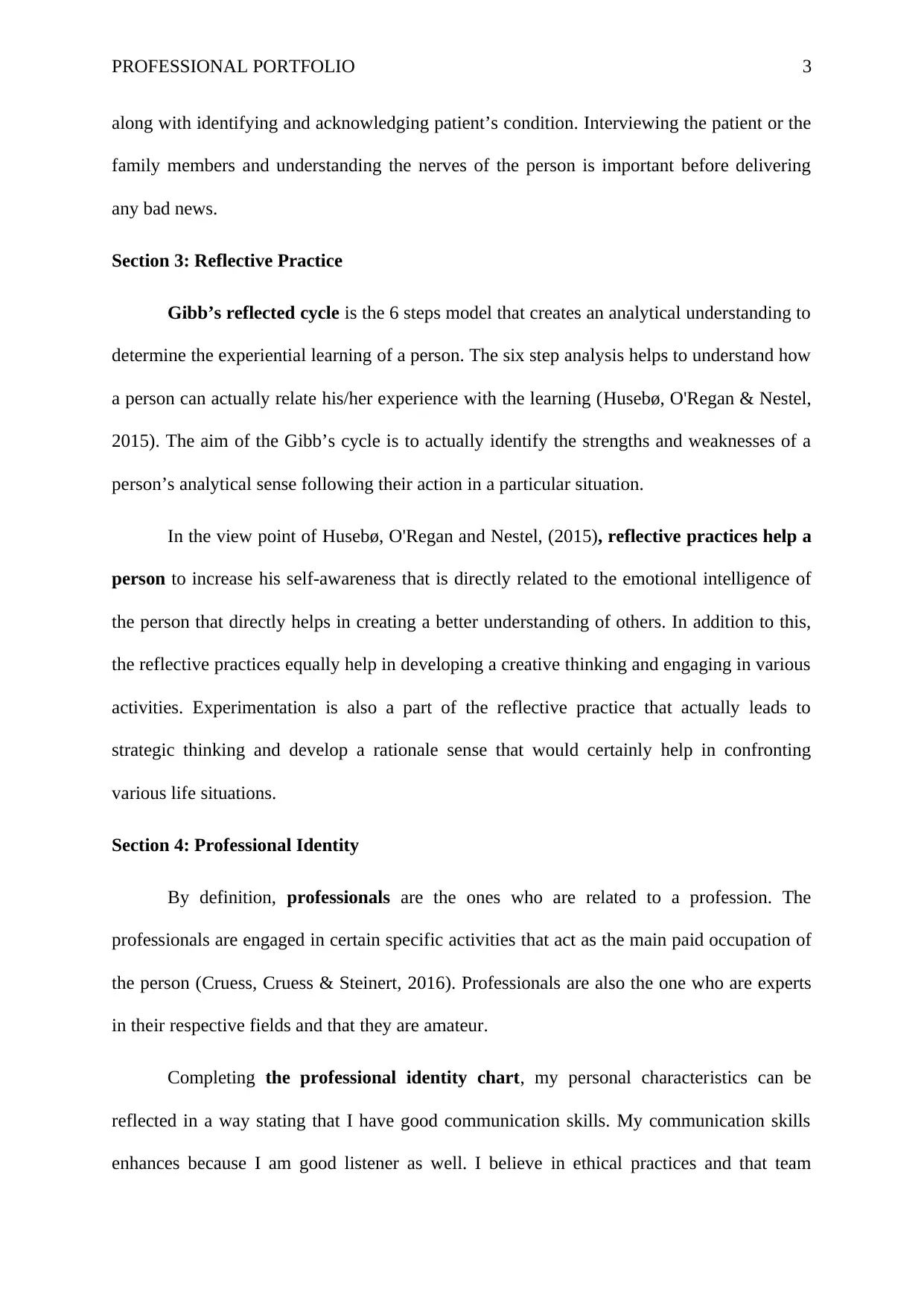
PROFESSIONAL PORTFOLIO 3
along with identifying and acknowledging patient’s condition. Interviewing the patient or the
family members and understanding the nerves of the person is important before delivering
any bad news.
Section 3: Reflective Practice
Gibb’s reflected cycle is the 6 steps model that creates an analytical understanding to
determine the experiential learning of a person. The six step analysis helps to understand how
a person can actually relate his/her experience with the learning (Husebø, O'Regan & Nestel,
2015). The aim of the Gibb’s cycle is to actually identify the strengths and weaknesses of a
person’s analytical sense following their action in a particular situation.
In the view point of Husebø, O'Regan and Nestel, (2015), reflective practices help a
person to increase his self-awareness that is directly related to the emotional intelligence of
the person that directly helps in creating a better understanding of others. In addition to this,
the reflective practices equally help in developing a creative thinking and engaging in various
activities. Experimentation is also a part of the reflective practice that actually leads to
strategic thinking and develop a rationale sense that would certainly help in confronting
various life situations.
Section 4: Professional Identity
By definition, professionals are the ones who are related to a profession. The
professionals are engaged in certain specific activities that act as the main paid occupation of
the person (Cruess, Cruess & Steinert, 2016). Professionals are also the one who are experts
in their respective fields and that they are amateur.
Completing the professional identity chart, my personal characteristics can be
reflected in a way stating that I have good communication skills. My communication skills
enhances because I am good listener as well. I believe in ethical practices and that team
along with identifying and acknowledging patient’s condition. Interviewing the patient or the
family members and understanding the nerves of the person is important before delivering
any bad news.
Section 3: Reflective Practice
Gibb’s reflected cycle is the 6 steps model that creates an analytical understanding to
determine the experiential learning of a person. The six step analysis helps to understand how
a person can actually relate his/her experience with the learning (Husebø, O'Regan & Nestel,
2015). The aim of the Gibb’s cycle is to actually identify the strengths and weaknesses of a
person’s analytical sense following their action in a particular situation.
In the view point of Husebø, O'Regan and Nestel, (2015), reflective practices help a
person to increase his self-awareness that is directly related to the emotional intelligence of
the person that directly helps in creating a better understanding of others. In addition to this,
the reflective practices equally help in developing a creative thinking and engaging in various
activities. Experimentation is also a part of the reflective practice that actually leads to
strategic thinking and develop a rationale sense that would certainly help in confronting
various life situations.
Section 4: Professional Identity
By definition, professionals are the ones who are related to a profession. The
professionals are engaged in certain specific activities that act as the main paid occupation of
the person (Cruess, Cruess & Steinert, 2016). Professionals are also the one who are experts
in their respective fields and that they are amateur.
Completing the professional identity chart, my personal characteristics can be
reflected in a way stating that I have good communication skills. My communication skills
enhances because I am good listener as well. I believe in ethical practices and that team
Paraphrase This Document
Need a fresh take? Get an instant paraphrase of this document with our AI Paraphraser
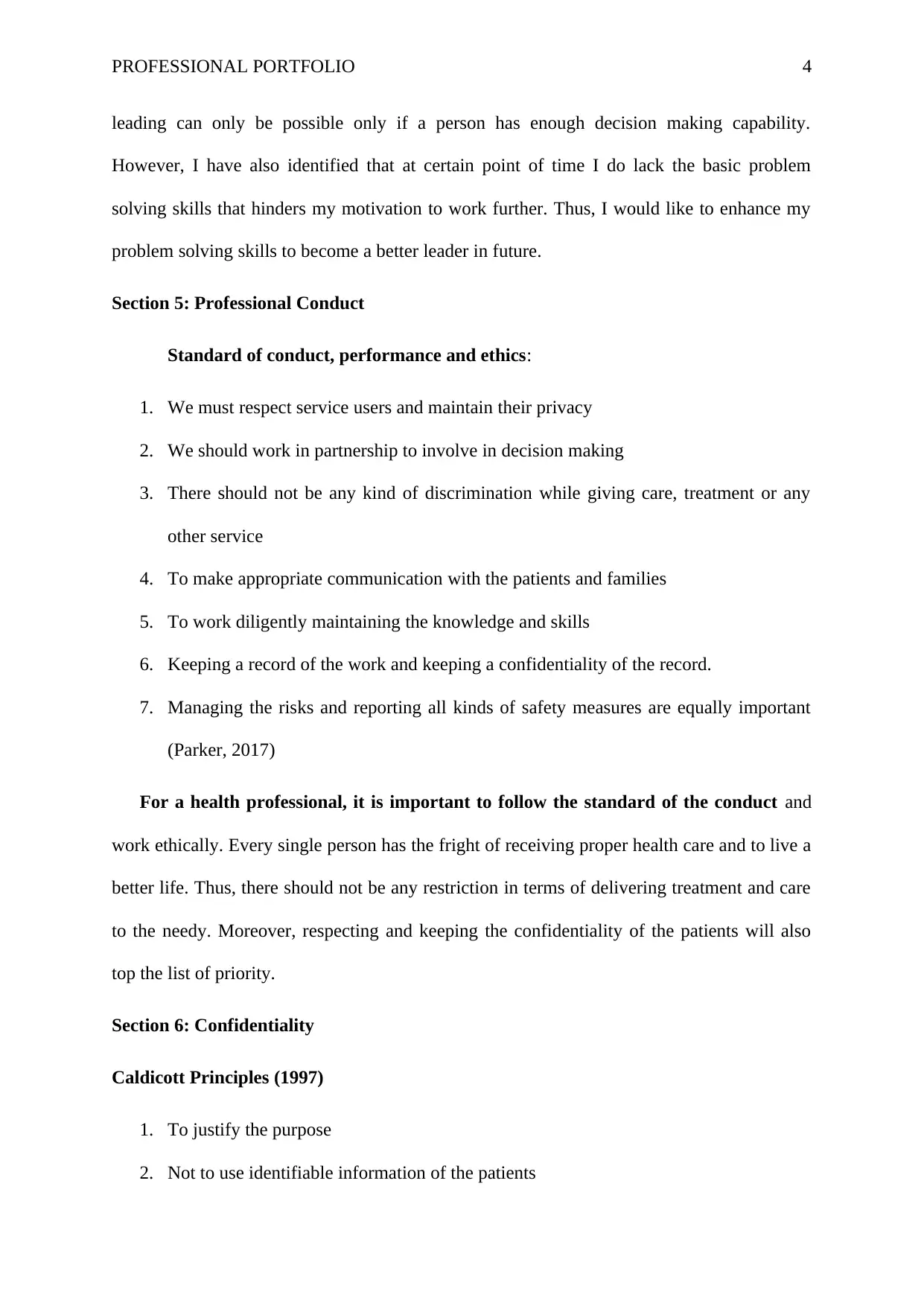
PROFESSIONAL PORTFOLIO 4
leading can only be possible only if a person has enough decision making capability.
However, I have also identified that at certain point of time I do lack the basic problem
solving skills that hinders my motivation to work further. Thus, I would like to enhance my
problem solving skills to become a better leader in future.
Section 5: Professional Conduct
Standard of conduct, performance and ethics:
1. We must respect service users and maintain their privacy
2. We should work in partnership to involve in decision making
3. There should not be any kind of discrimination while giving care, treatment or any
other service
4. To make appropriate communication with the patients and families
5. To work diligently maintaining the knowledge and skills
6. Keeping a record of the work and keeping a confidentiality of the record.
7. Managing the risks and reporting all kinds of safety measures are equally important
(Parker, 2017)
For a health professional, it is important to follow the standard of the conduct and
work ethically. Every single person has the fright of receiving proper health care and to live a
better life. Thus, there should not be any restriction in terms of delivering treatment and care
to the needy. Moreover, respecting and keeping the confidentiality of the patients will also
top the list of priority.
Section 6: Confidentiality
Caldicott Principles (1997)
1. To justify the purpose
2. Not to use identifiable information of the patients
leading can only be possible only if a person has enough decision making capability.
However, I have also identified that at certain point of time I do lack the basic problem
solving skills that hinders my motivation to work further. Thus, I would like to enhance my
problem solving skills to become a better leader in future.
Section 5: Professional Conduct
Standard of conduct, performance and ethics:
1. We must respect service users and maintain their privacy
2. We should work in partnership to involve in decision making
3. There should not be any kind of discrimination while giving care, treatment or any
other service
4. To make appropriate communication with the patients and families
5. To work diligently maintaining the knowledge and skills
6. Keeping a record of the work and keeping a confidentiality of the record.
7. Managing the risks and reporting all kinds of safety measures are equally important
(Parker, 2017)
For a health professional, it is important to follow the standard of the conduct and
work ethically. Every single person has the fright of receiving proper health care and to live a
better life. Thus, there should not be any restriction in terms of delivering treatment and care
to the needy. Moreover, respecting and keeping the confidentiality of the patients will also
top the list of priority.
Section 6: Confidentiality
Caldicott Principles (1997)
1. To justify the purpose
2. Not to use identifiable information of the patients
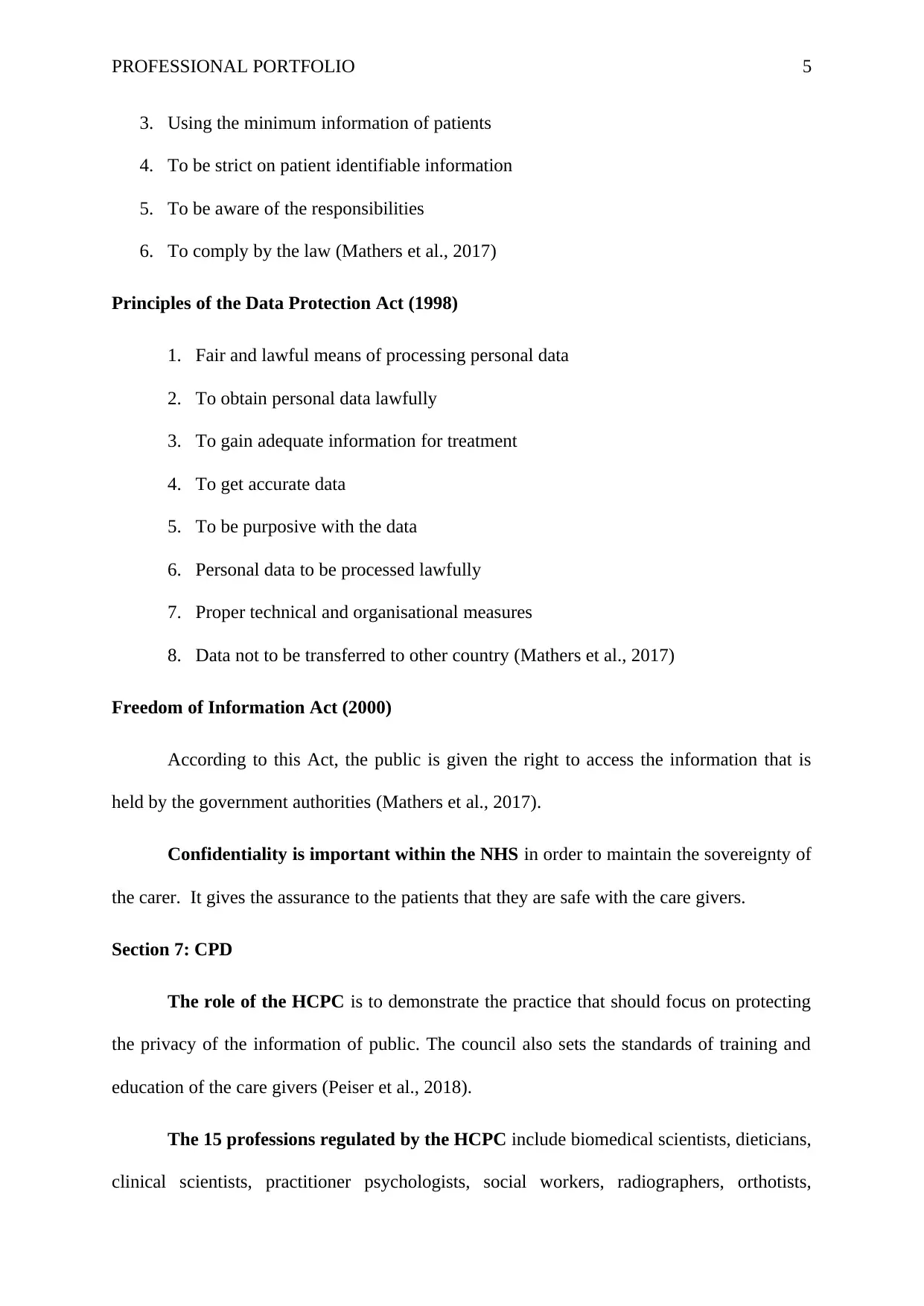
PROFESSIONAL PORTFOLIO 5
3. Using the minimum information of patients
4. To be strict on patient identifiable information
5. To be aware of the responsibilities
6. To comply by the law (Mathers et al., 2017)
Principles of the Data Protection Act (1998)
1. Fair and lawful means of processing personal data
2. To obtain personal data lawfully
3. To gain adequate information for treatment
4. To get accurate data
5. To be purposive with the data
6. Personal data to be processed lawfully
7. Proper technical and organisational measures
8. Data not to be transferred to other country (Mathers et al., 2017)
Freedom of Information Act (2000)
According to this Act, the public is given the right to access the information that is
held by the government authorities (Mathers et al., 2017).
Confidentiality is important within the NHS in order to maintain the sovereignty of
the carer. It gives the assurance to the patients that they are safe with the care givers.
Section 7: CPD
The role of the HCPC is to demonstrate the practice that should focus on protecting
the privacy of the information of public. The council also sets the standards of training and
education of the care givers (Peiser et al., 2018).
The 15 professions regulated by the HCPC include biomedical scientists, dieticians,
clinical scientists, practitioner psychologists, social workers, radiographers, orthotists,
3. Using the minimum information of patients
4. To be strict on patient identifiable information
5. To be aware of the responsibilities
6. To comply by the law (Mathers et al., 2017)
Principles of the Data Protection Act (1998)
1. Fair and lawful means of processing personal data
2. To obtain personal data lawfully
3. To gain adequate information for treatment
4. To get accurate data
5. To be purposive with the data
6. Personal data to be processed lawfully
7. Proper technical and organisational measures
8. Data not to be transferred to other country (Mathers et al., 2017)
Freedom of Information Act (2000)
According to this Act, the public is given the right to access the information that is
held by the government authorities (Mathers et al., 2017).
Confidentiality is important within the NHS in order to maintain the sovereignty of
the carer. It gives the assurance to the patients that they are safe with the care givers.
Section 7: CPD
The role of the HCPC is to demonstrate the practice that should focus on protecting
the privacy of the information of public. The council also sets the standards of training and
education of the care givers (Peiser et al., 2018).
The 15 professions regulated by the HCPC include biomedical scientists, dieticians,
clinical scientists, practitioner psychologists, social workers, radiographers, orthotists,
⊘ This is a preview!⊘
Do you want full access?
Subscribe today to unlock all pages.

Trusted by 1+ million students worldwide
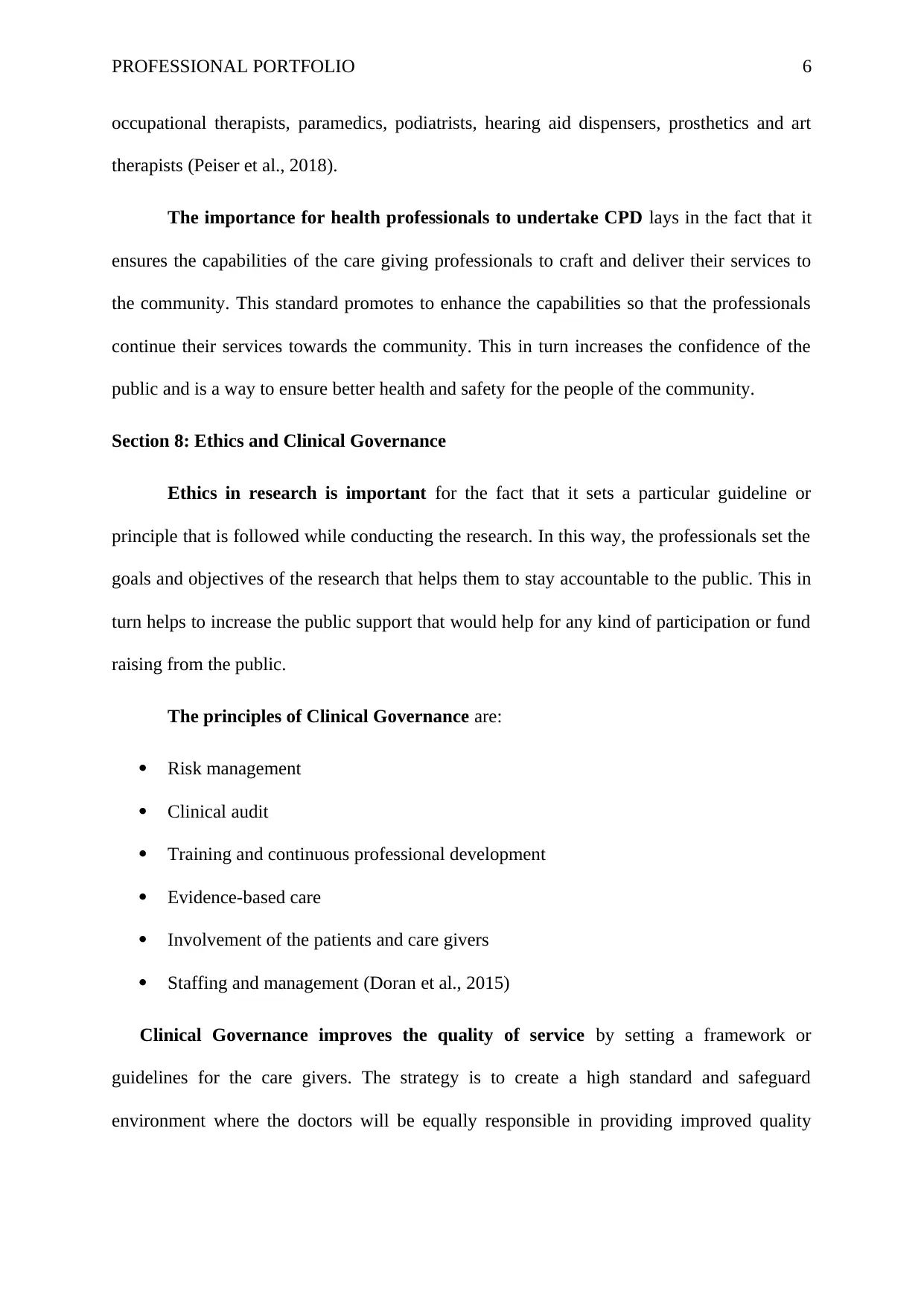
PROFESSIONAL PORTFOLIO 6
occupational therapists, paramedics, podiatrists, hearing aid dispensers, prosthetics and art
therapists (Peiser et al., 2018).
The importance for health professionals to undertake CPD lays in the fact that it
ensures the capabilities of the care giving professionals to craft and deliver their services to
the community. This standard promotes to enhance the capabilities so that the professionals
continue their services towards the community. This in turn increases the confidence of the
public and is a way to ensure better health and safety for the people of the community.
Section 8: Ethics and Clinical Governance
Ethics in research is important for the fact that it sets a particular guideline or
principle that is followed while conducting the research. In this way, the professionals set the
goals and objectives of the research that helps them to stay accountable to the public. This in
turn helps to increase the public support that would help for any kind of participation or fund
raising from the public.
The principles of Clinical Governance are:
Risk management
Clinical audit
Training and continuous professional development
Evidence-based care
Involvement of the patients and care givers
Staffing and management (Doran et al., 2015)
Clinical Governance improves the quality of service by setting a framework or
guidelines for the care givers. The strategy is to create a high standard and safeguard
environment where the doctors will be equally responsible in providing improved quality
occupational therapists, paramedics, podiatrists, hearing aid dispensers, prosthetics and art
therapists (Peiser et al., 2018).
The importance for health professionals to undertake CPD lays in the fact that it
ensures the capabilities of the care giving professionals to craft and deliver their services to
the community. This standard promotes to enhance the capabilities so that the professionals
continue their services towards the community. This in turn increases the confidence of the
public and is a way to ensure better health and safety for the people of the community.
Section 8: Ethics and Clinical Governance
Ethics in research is important for the fact that it sets a particular guideline or
principle that is followed while conducting the research. In this way, the professionals set the
goals and objectives of the research that helps them to stay accountable to the public. This in
turn helps to increase the public support that would help for any kind of participation or fund
raising from the public.
The principles of Clinical Governance are:
Risk management
Clinical audit
Training and continuous professional development
Evidence-based care
Involvement of the patients and care givers
Staffing and management (Doran et al., 2015)
Clinical Governance improves the quality of service by setting a framework or
guidelines for the care givers. The strategy is to create a high standard and safeguard
environment where the doctors will be equally responsible in providing improved quality
Paraphrase This Document
Need a fresh take? Get an instant paraphrase of this document with our AI Paraphraser
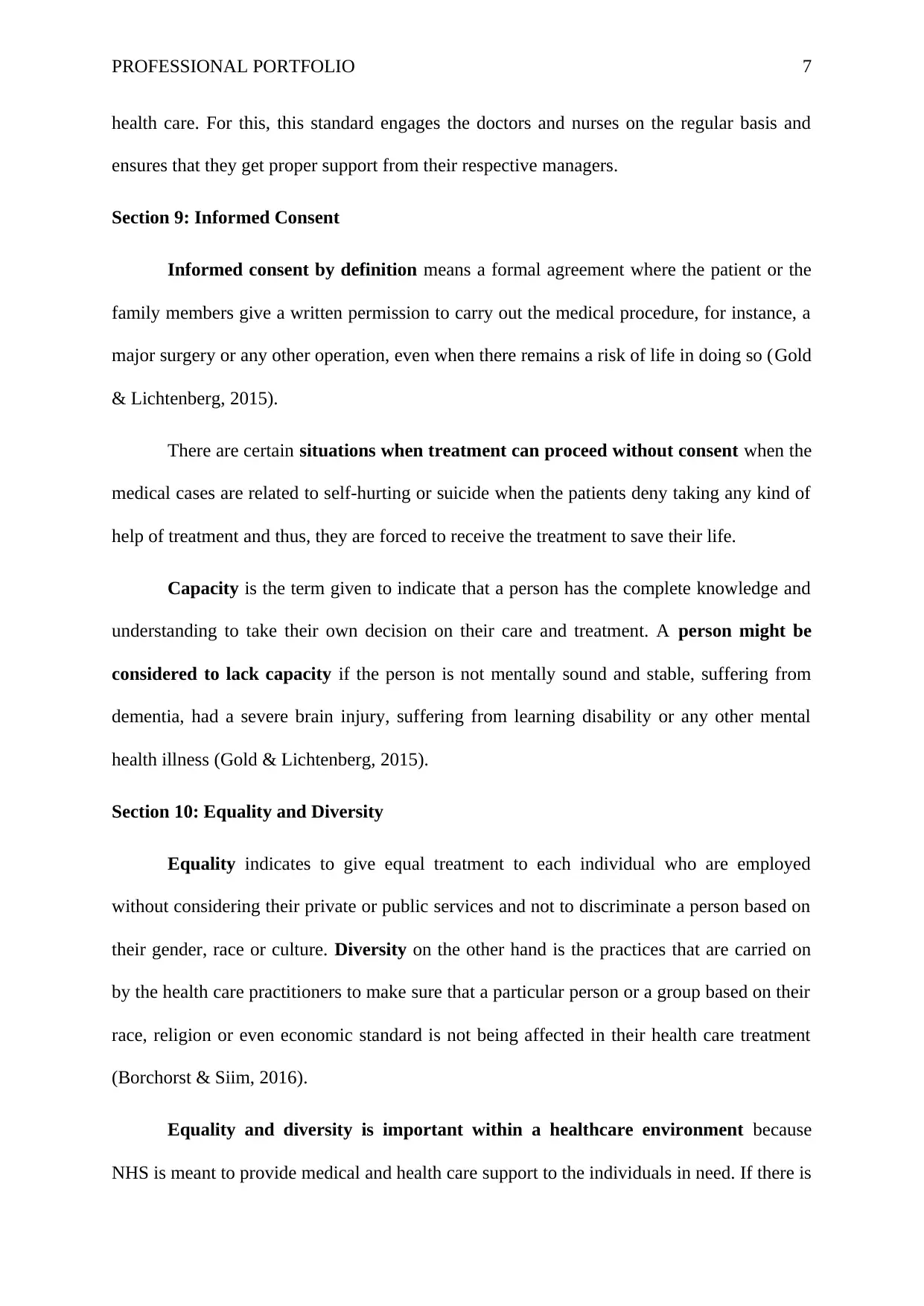
PROFESSIONAL PORTFOLIO 7
health care. For this, this standard engages the doctors and nurses on the regular basis and
ensures that they get proper support from their respective managers.
Section 9: Informed Consent
Informed consent by definition means a formal agreement where the patient or the
family members give a written permission to carry out the medical procedure, for instance, a
major surgery or any other operation, even when there remains a risk of life in doing so (Gold
& Lichtenberg, 2015).
There are certain situations when treatment can proceed without consent when the
medical cases are related to self-hurting or suicide when the patients deny taking any kind of
help of treatment and thus, they are forced to receive the treatment to save their life.
Capacity is the term given to indicate that a person has the complete knowledge and
understanding to take their own decision on their care and treatment. A person might be
considered to lack capacity if the person is not mentally sound and stable, suffering from
dementia, had a severe brain injury, suffering from learning disability or any other mental
health illness (Gold & Lichtenberg, 2015).
Section 10: Equality and Diversity
Equality indicates to give equal treatment to each individual who are employed
without considering their private or public services and not to discriminate a person based on
their gender, race or culture. Diversity on the other hand is the practices that are carried on
by the health care practitioners to make sure that a particular person or a group based on their
race, religion or even economic standard is not being affected in their health care treatment
(Borchorst & Siim, 2016).
Equality and diversity is important within a healthcare environment because
NHS is meant to provide medical and health care support to the individuals in need. If there is
health care. For this, this standard engages the doctors and nurses on the regular basis and
ensures that they get proper support from their respective managers.
Section 9: Informed Consent
Informed consent by definition means a formal agreement where the patient or the
family members give a written permission to carry out the medical procedure, for instance, a
major surgery or any other operation, even when there remains a risk of life in doing so (Gold
& Lichtenberg, 2015).
There are certain situations when treatment can proceed without consent when the
medical cases are related to self-hurting or suicide when the patients deny taking any kind of
help of treatment and thus, they are forced to receive the treatment to save their life.
Capacity is the term given to indicate that a person has the complete knowledge and
understanding to take their own decision on their care and treatment. A person might be
considered to lack capacity if the person is not mentally sound and stable, suffering from
dementia, had a severe brain injury, suffering from learning disability or any other mental
health illness (Gold & Lichtenberg, 2015).
Section 10: Equality and Diversity
Equality indicates to give equal treatment to each individual who are employed
without considering their private or public services and not to discriminate a person based on
their gender, race or culture. Diversity on the other hand is the practices that are carried on
by the health care practitioners to make sure that a particular person or a group based on their
race, religion or even economic standard is not being affected in their health care treatment
(Borchorst & Siim, 2016).
Equality and diversity is important within a healthcare environment because
NHS is meant to provide medical and health care support to the individuals in need. If there is
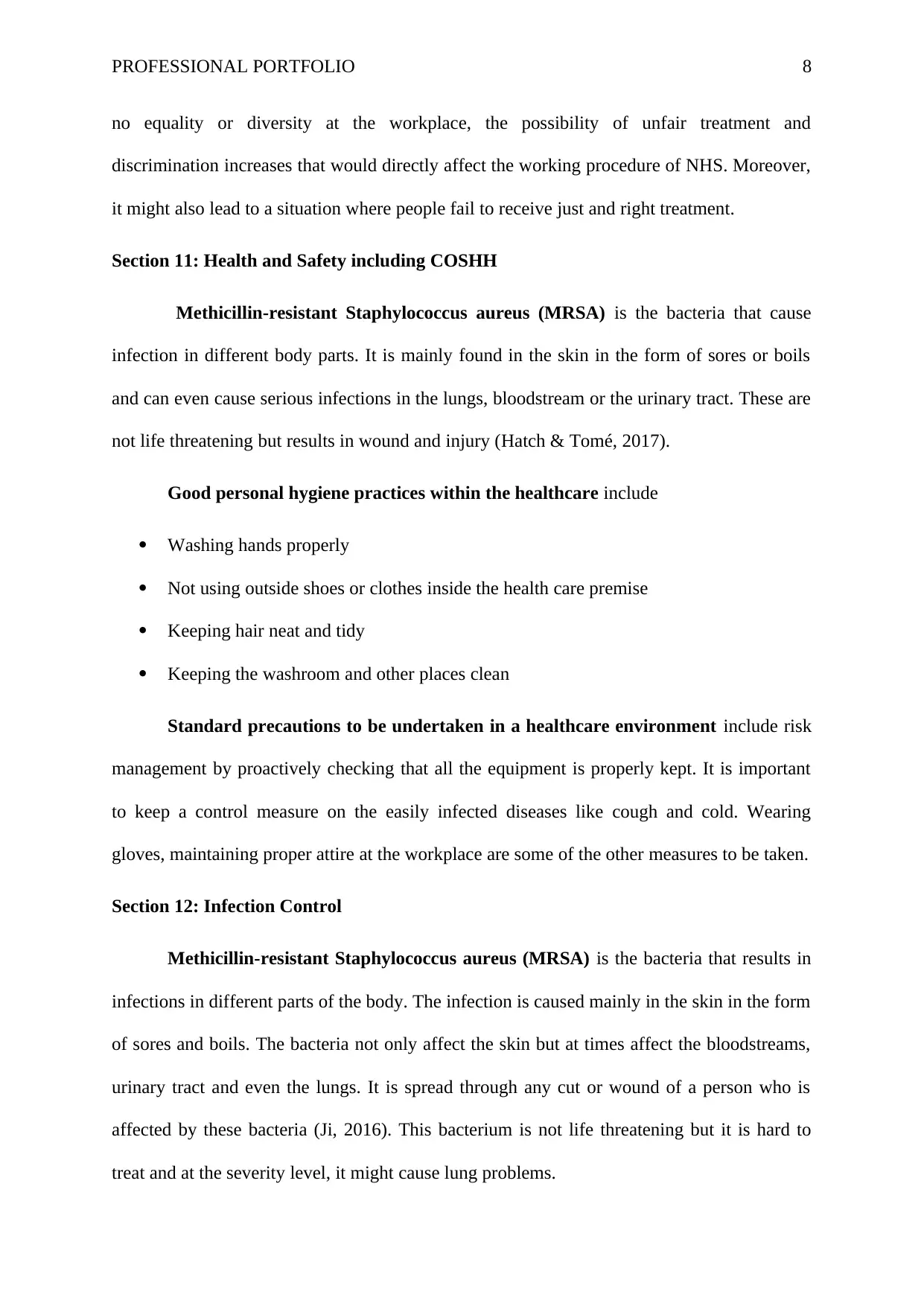
PROFESSIONAL PORTFOLIO 8
no equality or diversity at the workplace, the possibility of unfair treatment and
discrimination increases that would directly affect the working procedure of NHS. Moreover,
it might also lead to a situation where people fail to receive just and right treatment.
Section 11: Health and Safety including COSHH
Methicillin-resistant Staphylococcus aureus (MRSA) is the bacteria that cause
infection in different body parts. It is mainly found in the skin in the form of sores or boils
and can even cause serious infections in the lungs, bloodstream or the urinary tract. These are
not life threatening but results in wound and injury (Hatch & Tomé, 2017).
Good personal hygiene practices within the healthcare include
Washing hands properly
Not using outside shoes or clothes inside the health care premise
Keeping hair neat and tidy
Keeping the washroom and other places clean
Standard precautions to be undertaken in a healthcare environment include risk
management by proactively checking that all the equipment is properly kept. It is important
to keep a control measure on the easily infected diseases like cough and cold. Wearing
gloves, maintaining proper attire at the workplace are some of the other measures to be taken.
Section 12: Infection Control
Methicillin-resistant Staphylococcus aureus (MRSA) is the bacteria that results in
infections in different parts of the body. The infection is caused mainly in the skin in the form
of sores and boils. The bacteria not only affect the skin but at times affect the bloodstreams,
urinary tract and even the lungs. It is spread through any cut or wound of a person who is
affected by these bacteria (Ji, 2016). This bacterium is not life threatening but it is hard to
treat and at the severity level, it might cause lung problems.
no equality or diversity at the workplace, the possibility of unfair treatment and
discrimination increases that would directly affect the working procedure of NHS. Moreover,
it might also lead to a situation where people fail to receive just and right treatment.
Section 11: Health and Safety including COSHH
Methicillin-resistant Staphylococcus aureus (MRSA) is the bacteria that cause
infection in different body parts. It is mainly found in the skin in the form of sores or boils
and can even cause serious infections in the lungs, bloodstream or the urinary tract. These are
not life threatening but results in wound and injury (Hatch & Tomé, 2017).
Good personal hygiene practices within the healthcare include
Washing hands properly
Not using outside shoes or clothes inside the health care premise
Keeping hair neat and tidy
Keeping the washroom and other places clean
Standard precautions to be undertaken in a healthcare environment include risk
management by proactively checking that all the equipment is properly kept. It is important
to keep a control measure on the easily infected diseases like cough and cold. Wearing
gloves, maintaining proper attire at the workplace are some of the other measures to be taken.
Section 12: Infection Control
Methicillin-resistant Staphylococcus aureus (MRSA) is the bacteria that results in
infections in different parts of the body. The infection is caused mainly in the skin in the form
of sores and boils. The bacteria not only affect the skin but at times affect the bloodstreams,
urinary tract and even the lungs. It is spread through any cut or wound of a person who is
affected by these bacteria (Ji, 2016). This bacterium is not life threatening but it is hard to
treat and at the severity level, it might cause lung problems.
⊘ This is a preview!⊘
Do you want full access?
Subscribe today to unlock all pages.

Trusted by 1+ million students worldwide
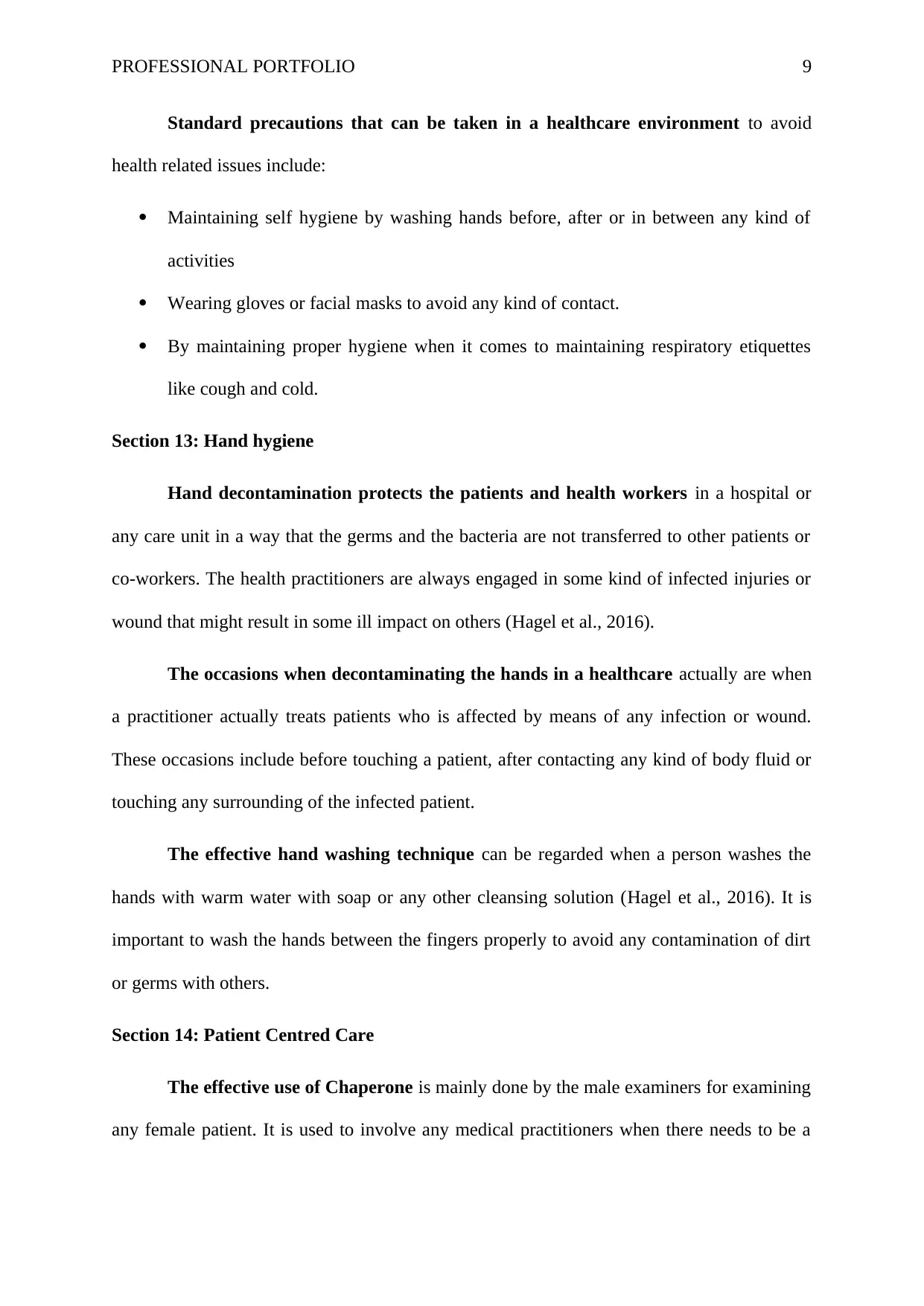
PROFESSIONAL PORTFOLIO 9
Standard precautions that can be taken in a healthcare environment to avoid
health related issues include:
Maintaining self hygiene by washing hands before, after or in between any kind of
activities
Wearing gloves or facial masks to avoid any kind of contact.
By maintaining proper hygiene when it comes to maintaining respiratory etiquettes
like cough and cold.
Section 13: Hand hygiene
Hand decontamination protects the patients and health workers in a hospital or
any care unit in a way that the germs and the bacteria are not transferred to other patients or
co-workers. The health practitioners are always engaged in some kind of infected injuries or
wound that might result in some ill impact on others (Hagel et al., 2016).
The occasions when decontaminating the hands in a healthcare actually are when
a practitioner actually treats patients who is affected by means of any infection or wound.
These occasions include before touching a patient, after contacting any kind of body fluid or
touching any surrounding of the infected patient.
The effective hand washing technique can be regarded when a person washes the
hands with warm water with soap or any other cleansing solution (Hagel et al., 2016). It is
important to wash the hands between the fingers properly to avoid any contamination of dirt
or germs with others.
Section 14: Patient Centred Care
The effective use of Chaperone is mainly done by the male examiners for examining
any female patient. It is used to involve any medical practitioners when there needs to be a
Standard precautions that can be taken in a healthcare environment to avoid
health related issues include:
Maintaining self hygiene by washing hands before, after or in between any kind of
activities
Wearing gloves or facial masks to avoid any kind of contact.
By maintaining proper hygiene when it comes to maintaining respiratory etiquettes
like cough and cold.
Section 13: Hand hygiene
Hand decontamination protects the patients and health workers in a hospital or
any care unit in a way that the germs and the bacteria are not transferred to other patients or
co-workers. The health practitioners are always engaged in some kind of infected injuries or
wound that might result in some ill impact on others (Hagel et al., 2016).
The occasions when decontaminating the hands in a healthcare actually are when
a practitioner actually treats patients who is affected by means of any infection or wound.
These occasions include before touching a patient, after contacting any kind of body fluid or
touching any surrounding of the infected patient.
The effective hand washing technique can be regarded when a person washes the
hands with warm water with soap or any other cleansing solution (Hagel et al., 2016). It is
important to wash the hands between the fingers properly to avoid any contamination of dirt
or germs with others.
Section 14: Patient Centred Care
The effective use of Chaperone is mainly done by the male examiners for examining
any female patient. It is used to involve any medical practitioners when there needs to be a
Paraphrase This Document
Need a fresh take? Get an instant paraphrase of this document with our AI Paraphraser
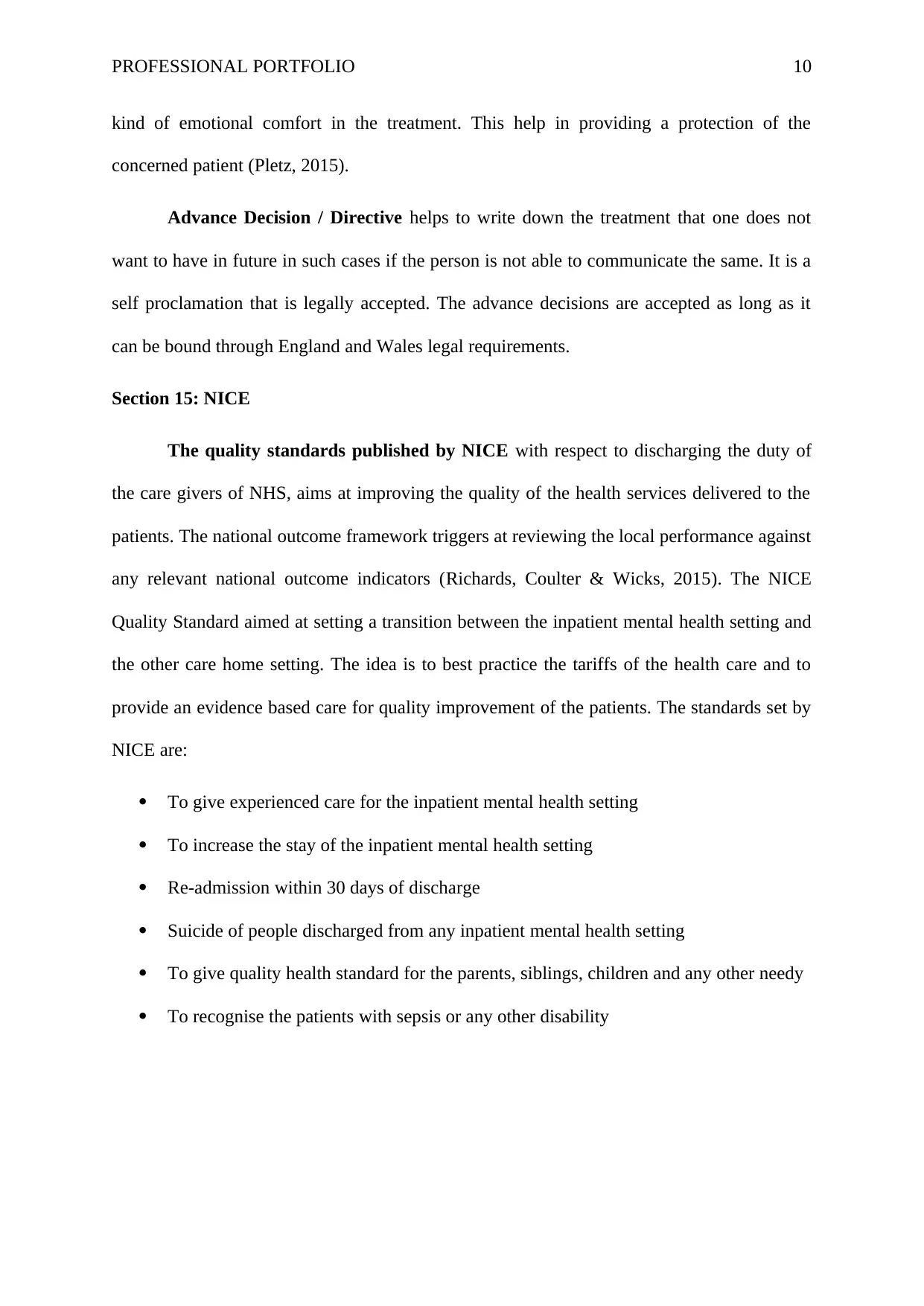
PROFESSIONAL PORTFOLIO 10
kind of emotional comfort in the treatment. This help in providing a protection of the
concerned patient (Pletz, 2015).
Advance Decision / Directive helps to write down the treatment that one does not
want to have in future in such cases if the person is not able to communicate the same. It is a
self proclamation that is legally accepted. The advance decisions are accepted as long as it
can be bound through England and Wales legal requirements.
Section 15: NICE
The quality standards published by NICE with respect to discharging the duty of
the care givers of NHS, aims at improving the quality of the health services delivered to the
patients. The national outcome framework triggers at reviewing the local performance against
any relevant national outcome indicators (Richards, Coulter & Wicks, 2015). The NICE
Quality Standard aimed at setting a transition between the inpatient mental health setting and
the other care home setting. The idea is to best practice the tariffs of the health care and to
provide an evidence based care for quality improvement of the patients. The standards set by
NICE are:
To give experienced care for the inpatient mental health setting
To increase the stay of the inpatient mental health setting
Re-admission within 30 days of discharge
Suicide of people discharged from any inpatient mental health setting
To give quality health standard for the parents, siblings, children and any other needy
To recognise the patients with sepsis or any other disability
kind of emotional comfort in the treatment. This help in providing a protection of the
concerned patient (Pletz, 2015).
Advance Decision / Directive helps to write down the treatment that one does not
want to have in future in such cases if the person is not able to communicate the same. It is a
self proclamation that is legally accepted. The advance decisions are accepted as long as it
can be bound through England and Wales legal requirements.
Section 15: NICE
The quality standards published by NICE with respect to discharging the duty of
the care givers of NHS, aims at improving the quality of the health services delivered to the
patients. The national outcome framework triggers at reviewing the local performance against
any relevant national outcome indicators (Richards, Coulter & Wicks, 2015). The NICE
Quality Standard aimed at setting a transition between the inpatient mental health setting and
the other care home setting. The idea is to best practice the tariffs of the health care and to
provide an evidence based care for quality improvement of the patients. The standards set by
NICE are:
To give experienced care for the inpatient mental health setting
To increase the stay of the inpatient mental health setting
Re-admission within 30 days of discharge
Suicide of people discharged from any inpatient mental health setting
To give quality health standard for the parents, siblings, children and any other needy
To recognise the patients with sepsis or any other disability
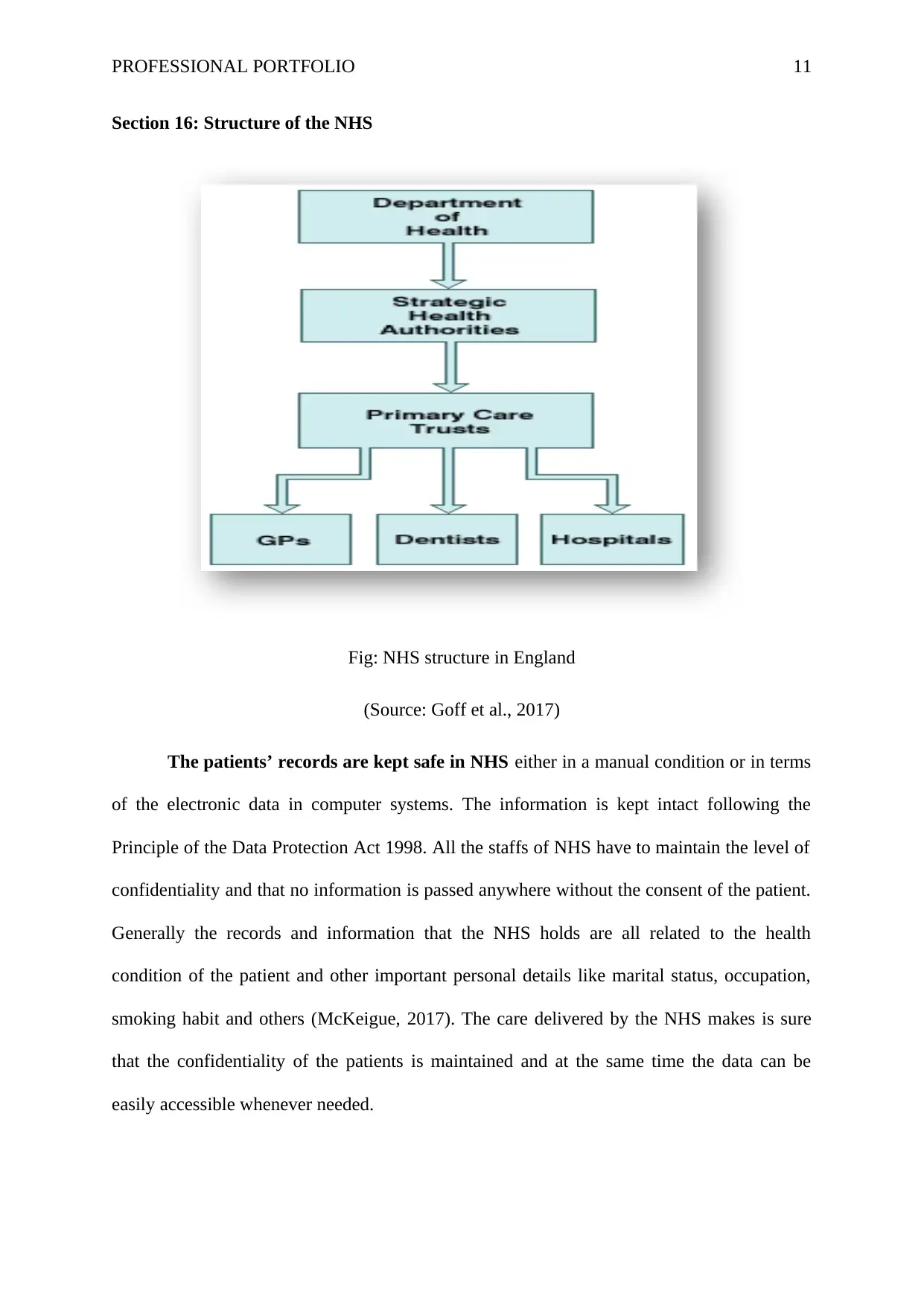
PROFESSIONAL PORTFOLIO 11
Section 16: Structure of the NHS
Fig: NHS structure in England
(Source: Goff et al., 2017)
The patients’ records are kept safe in NHS either in a manual condition or in terms
of the electronic data in computer systems. The information is kept intact following the
Principle of the Data Protection Act 1998. All the staffs of NHS have to maintain the level of
confidentiality and that no information is passed anywhere without the consent of the patient.
Generally the records and information that the NHS holds are all related to the health
condition of the patient and other important personal details like marital status, occupation,
smoking habit and others (McKeigue, 2017). The care delivered by the NHS makes is sure
that the confidentiality of the patients is maintained and at the same time the data can be
easily accessible whenever needed.
Section 16: Structure of the NHS
Fig: NHS structure in England
(Source: Goff et al., 2017)
The patients’ records are kept safe in NHS either in a manual condition or in terms
of the electronic data in computer systems. The information is kept intact following the
Principle of the Data Protection Act 1998. All the staffs of NHS have to maintain the level of
confidentiality and that no information is passed anywhere without the consent of the patient.
Generally the records and information that the NHS holds are all related to the health
condition of the patient and other important personal details like marital status, occupation,
smoking habit and others (McKeigue, 2017). The care delivered by the NHS makes is sure
that the confidentiality of the patients is maintained and at the same time the data can be
easily accessible whenever needed.
⊘ This is a preview!⊘
Do you want full access?
Subscribe today to unlock all pages.

Trusted by 1+ million students worldwide
1 out of 17
Related Documents
Your All-in-One AI-Powered Toolkit for Academic Success.
+13062052269
info@desklib.com
Available 24*7 on WhatsApp / Email
![[object Object]](/_next/static/media/star-bottom.7253800d.svg)
Unlock your academic potential
Copyright © 2020–2025 A2Z Services. All Rights Reserved. Developed and managed by ZUCOL.





